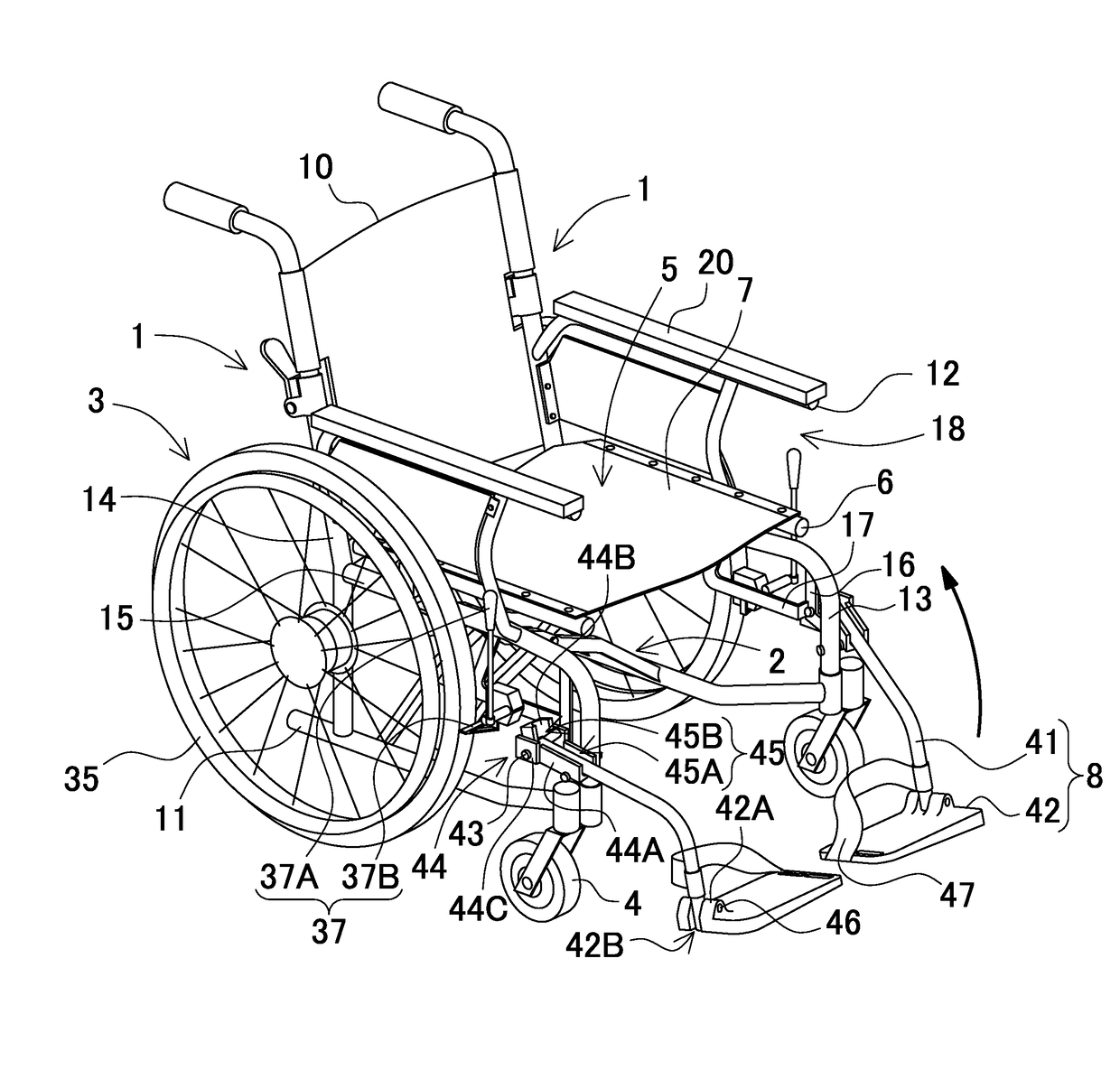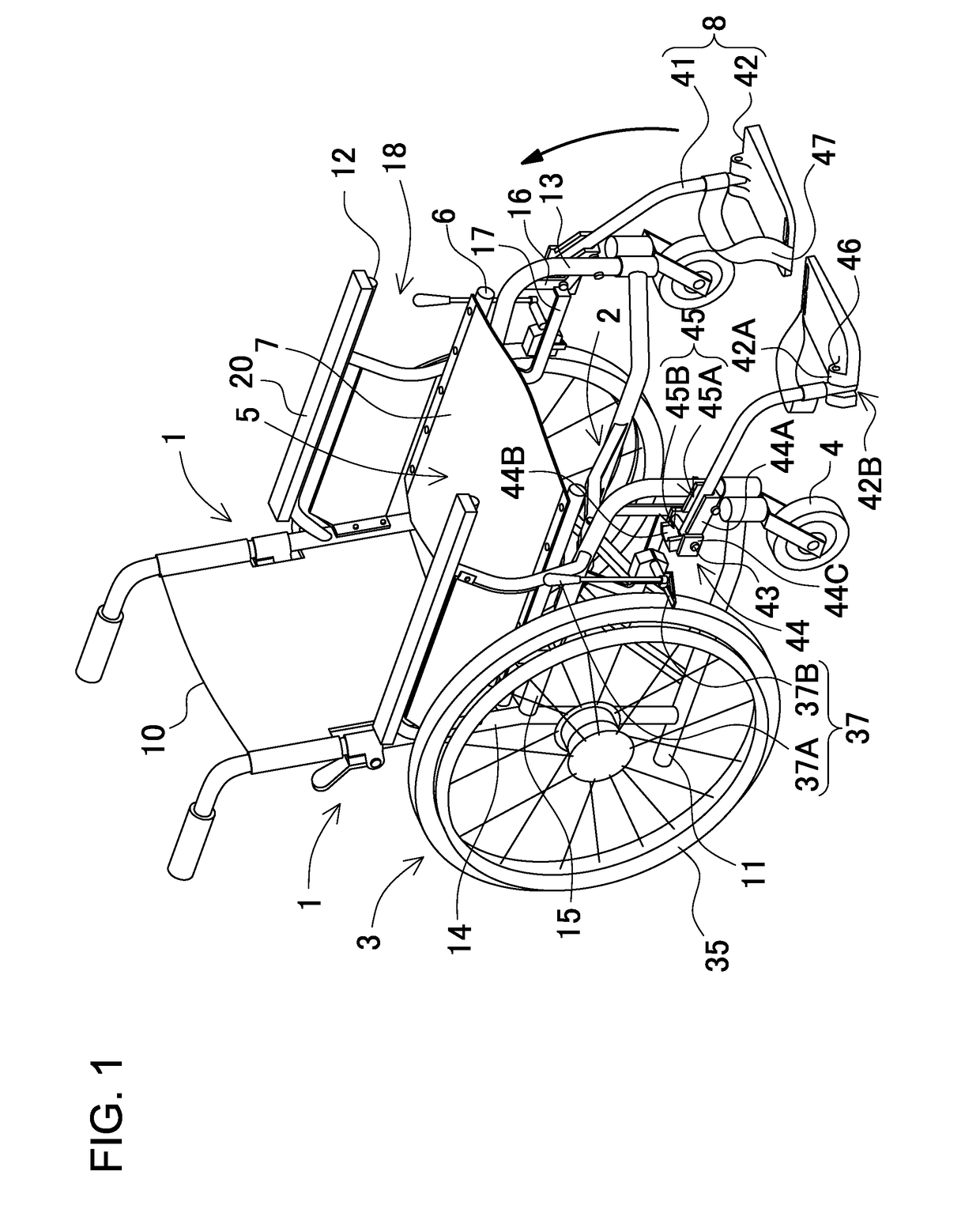Footrest-foldable wheelchair
a wheelchair and footrest technology, applied in wheelchairs/patient conveyances, medical transportation, ambulance services, etc., can solve the problems of user's foot slipping off the footrest plate through the space, and the distance between the right and left footrest plates is larger
- Summary
- Abstract
- Description
- Claims
- Application Information
AI Technical Summary
Benefits of technology
Problems solved by technology
Method used
Image
Examples
first embodiment
[0070]FIG. 1 is a perspective view showing a wheelchair according to a first embodiment. The wheelchair shown in FIG. 1 includes driving wheels 3, a pair of side frames 1, foldable links 2, seat frames 6, a flexible seat 7, casters 4, and footrests 8. The driving wheels 3 are coupled to the exterior sides of the side frames 1. The foldable links 2 couples the pair of side frames 1 to each other. The seat frames 6 are coupled to the top ends of the foldable links 2. The flexible seat 7 is coupled to the seat frames 6 of the foldable links 2. The casters 4 are coupled to the front parts of the side frames 1, and are free to swivel in the horizontal direction. The footrests 8 are coupled to the side frames 1. Each of the footrests 8 includes a footrest plate 42 that supports user's foot on its upper surface in an unfolded position, and a footrest arm 41 that is coupled to the side frame 1. The footrest plate 42 is coupled to the footrest arm 41. The side frames 1 of the wheelchair are ...
second embodiment
[0102]FIG. 8 is a plan view of a wheelchair according to a second embodiment. In the illustrated wheelchair, the footrest arms 41 are coupled to the exterior sides of the side frames 1 through the arm pivot shafts 43. The footrest arm 41 can be switched between the arm folded and unfolded positions.
(Arm Pivot Shaft 43)
[0103]The arm pivot shaft 43 is inclined in the horizontal plane of the wheelchair as shown in the plan view of FIG. 8. The illustrated arm pivot shaft 43 is inclined so that one of the both ends of the arm pivot shaft, which is located on the exterior side of the wheelchair, is positioned on the front side relative to another end, which is located on the interior side of the wheelchair. The angle of the arm pivot shaft 43 relative to a direction perpendicular to the side frame 1 is defined as an inclination angle γ. The inclination angle γ falls within the range from 1° to 30°. The inclination angle γ preferably falls within the range from 5° to 20°. The inclination a...
modified embodiment 1
[0109]The wheelchairs according to the first and second embodiments have been described. However, the way of reducing the gap between the right and left footrest plates in the plate unfolded position of the footrest plate is not limited to these. In the foregoing embodiments, even in the case where the footrest plates 42 has a roughly rectangular shape, the right and left plate pivot shafts 46 are inclined relative to the extension direction of the footrest arm 41 so that the opposed edges of the right and left footrest plates 42 are parallel to each other, and the gap between the opposed edges is constant. In a wheelchair according to a modified embodiment, the plate pivot shafts 46a are parallel to the extension direction of the footrest arms 41 but the opposed edges of the footrest plates 42 are parallel to each other, and the gap between the opposed edges is constant.
[0110]FIG. 10 is a plan view of the wheelchair according to this modified embodiment. Plate pivot shafts 46a for ...
PUM
 Login to View More
Login to View More Abstract
Description
Claims
Application Information
 Login to View More
Login to View More - R&D
- Intellectual Property
- Life Sciences
- Materials
- Tech Scout
- Unparalleled Data Quality
- Higher Quality Content
- 60% Fewer Hallucinations
Browse by: Latest US Patents, China's latest patents, Technical Efficacy Thesaurus, Application Domain, Technology Topic, Popular Technical Reports.
© 2025 PatSnap. All rights reserved.Legal|Privacy policy|Modern Slavery Act Transparency Statement|Sitemap|About US| Contact US: help@patsnap.com



